
Looking for How to Make Homemade Canned Baked Beans With Pork, Ham or Bacon - Easily! in 2025? Scroll down this page and follow the links. And if you bring home some fruit or vegetables and want to can, freeze, make jam, salsa or pickles, see this page for simple, reliable, illustrated canning, freezing or preserving directions. There are plenty of other related resources, click on the resources dropdown above. If you are having a hard time finding canning lids, I've used these, and they're a great price & ship in 2 days.
If you have questions or feedback, please let me know! There are affiliate links on this page. Read our disclosure policy to learn more.
How to Make Homemade Canned Baked Beans With Pork, Ham or Bacon - Easily!
How to Make Homemade Canned Baked Beans With Pork, Ham or Bacon - Easily! With Step-by-step Directions, Photos, Ingredients, Recipe
Yield: 7 to 9 pint jars
Click here for a PDF print version
Kidney, navy and other varieties of dried beans are good candidates for making your own homemade canned baked beans. Make your dog will try to sell your secret recipe, too, like the Bush's Baked beans, dog. In your own home garden, leave the beans on the vine to mature. They will dry naturally.
In canning the dried beans, there is a key tip: Water plays an important part in the final quality of canned baked beans. The harder the water used for soaking and blanching, the harder and firmer the finished beans. Also, excessive alkalinity will cause the beans to disintegrate somewhat, becoming soft and mushy. However, this will not be seen until after canning them. there's not much you can do about this, but try to avoid "softened" water.
The only other trick is, you really do need a Pressure Canner. Every university food science department and the government will tell you that it just is not safe to use the water bath bath method; it takes the higher temperatures of the pressure canner to kill the botulism bacteria.
See this FAQ for details: Can I use a water-bath canner instead of a Pressure Canner for low acid foods (like green beans, corn, meats)?
BUT, with a Pressure Canner it's easy. And although a Pressure Canner
costs $100 to $200 (see this page for pressure canners models, makes and prices), they last a lifetime, and your children and grandchildren may be using
it. You can also find free information from the USDA in this PDF
file (it will take a while to load!) about
selecting and using canners here! Pressure Canner works and its components" longdesc="Diagram of how a Pressure Canner works and its components" style="float: right">
Pressure Canner works and its components" longdesc="Diagram of how a Pressure Canner works and its components" style="float: right">
So, here's how to can baked beans, with some added pork or bacon. The directions are complete with instructions in easy steps and illustrated. In the winter when you open a jar, the baked beans will taste MUCH better than any store-bought canned baked beans.
Prepared this way, the jars have a shelf life of about 12 months, and aside from storing in a cool, dark place, require no special attention.
Ingredients
- Dried beans - An average of 5 pounds of beans is needed per canner load of 7 quarts; an average of 31/4 pounds is needed per canner load of 9 pints - an average of 3/4 pounds per quart. Select mature, dry seeds. Sort out and discard discolored seeds.
- Pieces of pork, ham, or bacon (Ball recommends seven 3/4-inch square pieces of pork, ham, or bacon per 3 cups of beans)
- 3 tablespoons dark molasses per 3 cups of beans
- 1 tablespoon vinegar per 3 cups of beans
- 2 teaspoons salt per 3 cups of beans (the salt is OPTIONAL),
- 3/4 teaspoon powdered dry mustard per 3 cups of beans
Equipment
- 1 Pressure Canner (a large pressure pot with a lifting rack to sanitize the jars after filling (about $75 to $200 at mall kitchen stores and "big box" stores, but it is cheaper online; see this page for more information). For low acid foods (most vegetables, you can't use an open water bath canner, it has to be a Pressure Canner to get the high temperatures to kill the bacteria. If you plan on canning every year, they're worth the investment.
- Jar grabber (to pick up the hot jars)
- Jar funnel ($4 at mall kitchen stores and local "big box" stores, but it's usually cheaper online from our affiliates)
- At least 1 large pot
- Colander or sieve
- Large spoons and ladles,
- Canning jars (often called Ball jars, Mason jars or Kerr jars) (Publix, Kroger, other grocery stores and some "big box" stores carry them - now about $12 per dozen quart jars (up 50% in 2 years!) including the lids and rings)
Directions - Step by Step
Step 1 - Clean the beans
Soak and boil the beans as follows: Sort and wash drain the beans in a strainer or collander in the sink under running clean, cool or warm water.
Step 2 - Boil and soak the beans
Then in a large pot, add 3 cups of water for each cup of dried beans or peas. Bring to a boil for 2 minutes, then remove from the heat and set the pot aside to soak for 1 hour. After 1 hour, drain the liquid from the beans. Discard the liquid!
Step 3 - Re-heat the beans in the pot of boiling water
Again, heat the beans to boiling in the fresh boiling water from step 3,
and this time save the liquid for making sauce.
Step 4 - Prepare the molasses sauce
Mix 4 cups water or cooking liquid from beans in step 4, with 3 tablespoons dark molasses, 1 tablespoon vinegar, 2 teaspoons salt (the salt is OPTIONAL), and 3/4 teaspoon powdered dry mustard. Heat to boiling. You may susbtitute 1 tablespoon of lemon juice for the vinegar, if you have an allergy to vinegar.
Step 5 - Prepare the meat (pork, bacon or ham)
Place seven 3/4-inch square pieces of pork, ham, or bacon per 3 cups of beans in an earthenware crock, a large casserole, or a pan.
Step 6 - Add the beans and molasses and bake
Add the drained beans and enough molasses sauce to cover beans. Cover and bake 4 to 5 hours at 350ºF. Add water as needed, so they don't dry out or burn - usually that's once per hour.

Step 7 - With 30 minutes to go, prepare the jars and pressure canner
Wash the jars and lids
This is a good time to get the jars ready! The dishwasher is fine for the jars; especially if it has a "sanitize" cycle. Otherwise put the jars in boiling water for 10 minutes. I just put the lids in a small pot of almost boiling water for 5 minutes, and use the magnetic "lid lifter wand" (available from target, other big box stores, and often grocery stores; and available online - see this page) to pull them out.
Get a large pot of water boiling
Again, 3 cups of water for each cup of dried beans or peas, same as in step 2. We will use this water to pour over the beans and fill each jar with liquid, after we've packed them full of beans. I use the largest pot I have, so that there is plenty of clean, boiling water ready when I need it.
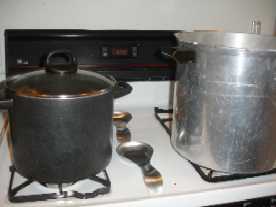
Get the pressure canner heating up
Rinse out your pressure canner, put the rack plate in the bottom, and fill it to a depth of 4 inches with hot tap water. (of course, follow the instruction that came with the canner, if they are different). Put it on the stove over low heat, with the lid OFF of it, just to get it heating up for later on.
Get your oven heating to 350 F.
Step 8 - Fill the jars and put the lids and rings on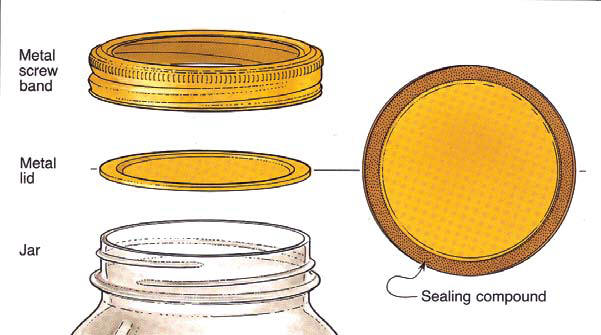
Fill the jars, leaving 1-inch headspace. Put the lids on each jar and seal them by putting a ring on and screwing it down snugly (but not with all your might, just "snug")
.
Step 9 - Put the jars in the canner and the lid on the canner (but still vented)
Using the jar tongs, put the jars on the rack in the canner. By now the water level has probably boiled down to 3 inches. If it is lower than that, add more hot tap water to the canner. When all the jars that the canner will hold are in, put on the lid and twist it into place, but leave the weight off (or valve open, if you have that type of pressure canner).
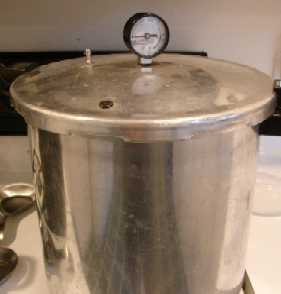 Step 10 - Let the canner vent steam for 10 minutes
Step 10 - Let the canner vent steam for 10 minutes
Put the heat on high and let the steam escape through the vent for 10 minutes to purge the airspace inside the canner.
Step 11 - Put the weight on and let the pressure build
After 10 minutes of venting, put the weight on and close any openings to allow the pressure to build to 11 pounds.
Step 12 - Process for 65 minutes for pint jars, 75 minutes for quarts
Once the gauge hits 10/11 pounds, as appropriate for your type of canner, start your timer going. Adjust the heat, as needed, to maintain 10 pounds of pressure.
Note: the chart below will help you determine the right processing time and pressure, if different types of canner, or are above sea level.
| Table 1. Recommended process time for Beans, Baked in a dial-gauge pressure canner. | ||||||
| Canner Pressure (PSI) at Altitudes of | ||||||
| Style of Pack | Jar Size | Process Time | 0 - 2,000 ft | 2,001 - 4,000 ft | 4,001 - 6,000 ft | 6,001 - 8,000 ft |
| Hot | Pints | 65 min | 11 lb | 12 lb | 13 lb | 14 lb |
| Quarts | 75 | 11 | 12 | 13 | 14 | |
| Table 2. Recommended process time for Beans, Baked in a weighted-gauge pressure canner. | ||||
| Canner Pressure (PSI) at Altitudes of | ||||
| Style of pack | Jar Size | Process Time | 0 - 1,000 ft | Above 1,000 ft |
| Hot | Pints | 65 min | 10 lb | 15 lb |
| Quarts | 75 | 10 | 15 | |
It is important to learn how to operate your pressure canner by reading the owner's manual that came with your particular canner. If you cannot find your owner's manual, you can obtain find one online: Here is where to find some common manufacturer's manuals:
or by contacting the company that made your canner. Give the model number
to the manufacturer, and they will send you the right manual. Click here for more information about pressure canners and a variety of models you can order.
Insert tables here!
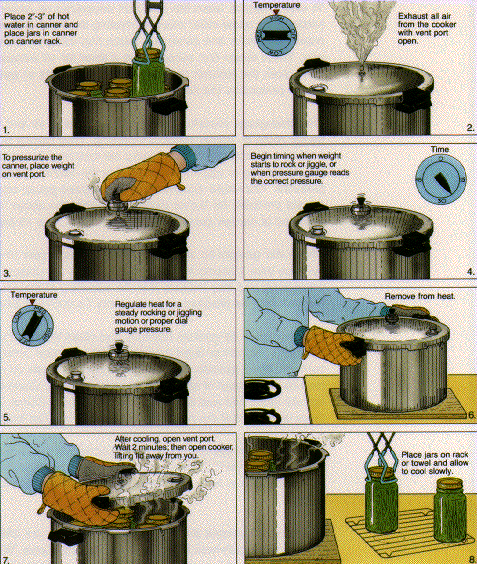
Step 13 - Turn off the heat and let it cool down
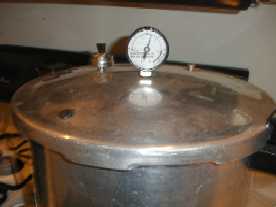
When the processing time from the chart above is up, turn off the heat, and allow the pressure canner to cool and the pressure to drop to zero before opening the canner. Let the jars cool without being jostled. After the pressure drops to zero (usually, you can tell but the "click" sound of the safety release vents opening, as well as but the gauge. Let the pressure in the canner drop to zero by itself. This may take 45 minutes in a 16-quart canner filled with jars and almost an hour in a 22-quart canner. If the vent is opened before the pressure drops to zero OR if the cooling is rushed by running cold water over the canner, liquid will be lost from the jars. Too rapid cooling causes loss of liquid in the jars!
Step 14 - Remove the jars
Lift the jars out of the water and let them cool on a wooden cutting board or a towel, without touching or bumping them in a draft-free place (usually takes overnight), here they won't be bumped. You can then remove the rings if you like, but if you leave them on, at least loosen them quite a bit, so they don't rust in place due to trapped moisture. Once the jars are cool, you can check that they are sealed verifying that the lid has been sucked down. Just press in the center, gently, with your finger. If it pops up and down (often making a popping sound), it is not sealed. If you put the jar in the refrigerator right away, you can still use it. Some people replace the lid and reprocess the jar, then that's a bit iffy. If you heat the contents back up, re-jar them (with a new lid) and the full time in the canner, it's usually ok. You're done!
This document was adapted from the "Complete Guide to Home Canning," Agriculture Information Bulletin No. 539, USDA, revised 2009. Reviewed November 2009.
Tips
Questions, Answers, Comments and Feedback
- A visitor writes on May 04, 2013: "Ok so... I made the best
baked beans ever. After soaking the beans overnight I pressure cooked
(steamed) them for 6 minutes, added ingredients and baked them for 6 hrs
in a conventional oven. I want to can the baked beans to preserve them
so I can go to the basement and get a jar of these delicious baked
beans. This recipe has bacon in it. Should I pressure can or water bath
canthe baked beans from the oven is my question. Thanks, I come back to
your site all the time. Bob in NY "
Answer: Since the item to be canned with have meat in it, it must be pressure canned, following the steps in the recipe above!
Illustrated Canning, Freezing, Jam Instructions and Recipes
[ Easy Home Canning Directions] [FAQs - Answers to common questions and problems] [Recommended books about home canning, jam making, drying and preserving!] [Free canning publications to download and print]
Looking for canning equipment and supplies?
Water bath canner with a jar rack
Pressure canners for gas, electric and induction stoves: Presto 23Qt or T-fal 22Qt
Canning scoop (this one is PERFECT)
Ball Blue book (most recent version)
Jars: 8oz canning jars for jams
Find Other types of farms:
Farm markets and roadside stands
Road trips and camping resources
Local Honey, apiaries, beekeepers
Consumer fraud and scams information
Home canning supplies at the best prices on the internet!
Maple Syrup Farms, sugarworks, maple syrup festivals
Environmental information and resources
Farms For Your Event for birthday parties, weddings, receptions, business meetings, retreats, etc.
Festivals - local fruit and vegetable festivals
Get the
most recent version of
the Ball Blue Book
With this Presto 23 quart pressure canner and pressure cooker, you can "can" everything, fruits, vegetables, jams, jellies, salsa, applesauce, pickles, even meats, soups, stews. Model 01781

You can make jams, jellies, can fruit, applesauce, salsa and pickles with water bath canners, like this Granite Ware 12-Piece Canner Kit, Jar Rack, Blancher, Colander and 5 piece Canning Tool Set


